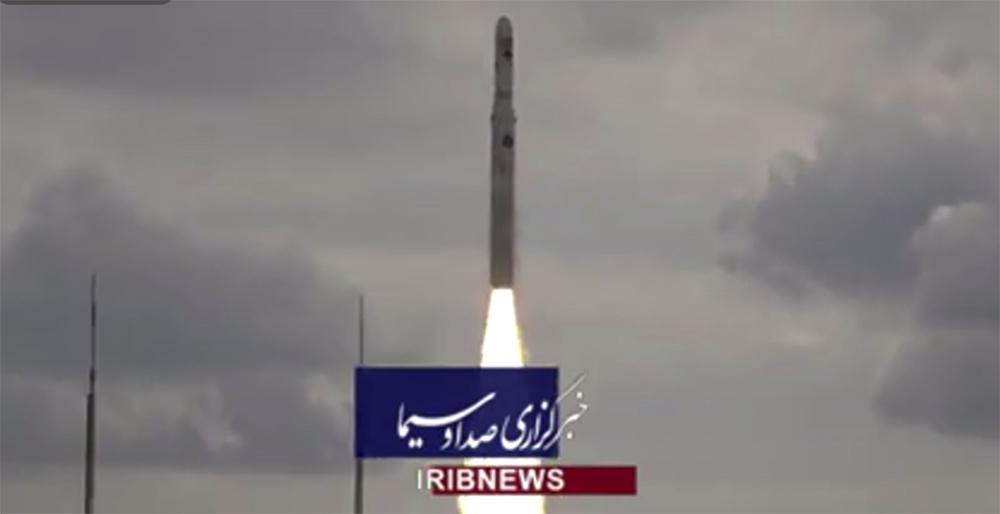Iran’s powerful paramilitary Revolutionary Guard on Saturday launched a new satellite-carrying rocket, state TV reported, seeking to demonstrate the hard-line force’s prowess even as anti-government protests rage across the country.
Iranian state TV said the Guard successfully launched the solid-fueled rocket — what it called a Ghaem-100 satellite carrier — and aired dramatic footage of the rocket blasting off from a desert launch pad into a cloudy sky. The report did not reveal the location, which resembled Iran’s northeastern Shahroud Desert.
The state-run IRNA news agency reported that the carrier would be able to put a satellite weighing 80 kg (176 pounds) into orbit some 500 kilometers (310 miles) from Earth.
Gen. Amir Ali Hajizadeh, the commander of the Guard’s aerospace division, said he hoped the Guard would soon use the rocket to put a new satellite, named Nahid, into orbit.
Iran says its satellite program, like its nuclear activities, is aimed at scientific research and other civilian applications. The United States and other Western countries have long been suspicious of the program because the same technology can be used to develop long-range missiles. Previous launches have drawn rebukes from the U.S.
The Guard operates its own space program and military infrastructure parallel to Iran’s regular armed forces and answers only to Supreme Leader Ayatollah Ali Khamenei.
Over the past decade, Iran has sent several short-lived satellites into orbit and in 2013 launched a monkey into space. The program has seen recent troubles, however. There have been five failed launches in a row for the Simorgh program, another satellite-carrying rocket.
A fire at the Imam Khomeini Spaceport in February 2019 killed three researchers, authorities said at the time. A launchpad rocket explosion later that year drew the attention of former President Donald Trump.
The Guard’s announcement came in the seventh week of protests sparked by the death in custody of 22-year-old Mahsa Amini, who was detained after allegedly violating the country’s strict dress code for women.
The protests embroiling the country first focused on the state-mandated headscarf, or hijab, but swiftly morphed into one of the biggest challenges to the government since the 1979 Islamic Revolution. Protesters chant for overthrowing the clerical rule and the death of Khamenei.
Security forces, including paramilitary volunteers with the Revolutionary Guard, have violently cracked down on the demonstrations, killing over 300 people, including 41 children, according to the Oslo-based Iran Human Rights.
On Saturday, student unions in Iran reported protests in at least six major universities across the country. Universities have been hubs for unrest, fueling the protest movement despite the crackdown.
Anger over Iran’s sickly economy, suffocated by U.S. sanctions and years of mismanagement, has also driven people into the streets. Talks to revive Iran’s nuclear deal with world powers, which granted Tehran sanctions relief in exchange for strict curbs on its atomic program, hit a deadlock months ago.
On Saturday, Iran’s currency, the rial, plunged to its lowest value ever against the dollar. Iran’s currency was trading at 360,000 rials to the dollar, compared to 32,000 rials to the dollar at the time of the 2015 nuclear accord.
The southeastern Sistan and Baluchestan province was gripped by unrest on Friday, drawing a lethal response from security forces. Advocacy group HalVash claimed security forces killed at least 16 people.
Iran’s prominent Sunni cleric Mowlavi Abdolhamid Esmailzehi on Saturday condemned the violence in Sistan and Baluchestan as another “bloody disaster,” saying that security forces opened fire on protesters who were only “chanting slogans and throwing stones” outside the governor’s office.
The judiciary of Sistan and Baluchestan announced Saturday that 620 people had been arrested in the province during the unrest, with 45 people sentenced so far on charges of damaging public property and encouraging youth on social media to join protests.
(AP)











